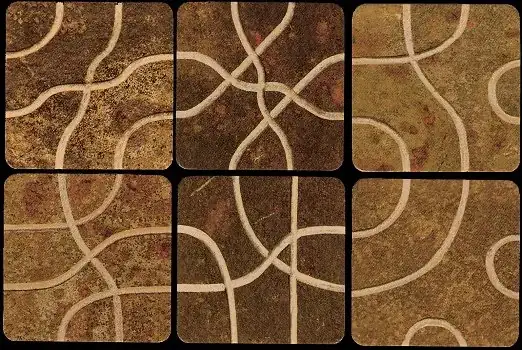One can reduce further the $105$ possible tiles, down to the minimum possible of $35$ topologically unique tiles via $mod\, 8$ arithmetic, $1+7=(8)=0$.
Modulo $8$ arithmetic (each tile has $8$ ports numbered $0123457$) allows $CW$ and $CCW 2$-dimensional rotations (can not flip a tile, as a flip would represent a $3D$ rotation). To keep this simple, there are no negative integers here, $0-1=7$ is being interpreted as $7+1=0$.
A $45^{\circ}$ rotation is represented by adding/subtracting 1 to/from the port #.
Rotations of $90^{\circ}, 180^{\circ}, 270^{\circ}$ are represented by adding/subtracting $2, 4, 6$ respectively. I just added $2, 4, 6$ used only addition.
Represent a pair of two connected ports of a tile by a $2$-digit number. For example $15$ means port#1 is connected to port#5, i.e. not decimal fifteen.
Represent each tile via a quad set of number pairs, non repeating digits,for example $\{01, 23, 45, 67\}$.
Note $\{01, 14, 26, 57\}$ is not a valid tile as digit "1" -port#1- appears twice.
Example of $180^{\circ}$ rotation:
Tile $\{04, 12, 36, 57\}$ is rotated $180^{\circ}$ by adding (modulo 8) $+4$ to each of its digits.
$$0+4=4$$
$$4+4=(8)=0$$
$$1+4=5$$
$$2+4=6$$
$$3+4=7$$
$$6+4=(10)=2$$
$$5+4=(9)=1$$
$$7+4=(11)=3$$
Thus rotated tile becomes $\{40, 56, 72, 13\}$ and will order/describe/ its ports from low-to-high (as each numbers-pair is commutative, $40=04$ and $72=27$).
Therefore this $180^{\circ}$ rotated tile becomes $\{04, 13, 27, 56\}$.
Rotate all $105$ tiles by $0^{\circ}, 90^{\circ}, 180^{\circ}, 270d^{\circ}$, (find & write all quad sets).
Use Excel, reorder the port# numbers from low-to-high, and eliminate all duplicate tiles.
End result = $35$ unique quad sets representing $35$ unique tiles.
May follow my analysis summary at:
https://boardgamegeek.com/thread/1398585/tsuro-35-unique-tiles-math-proof-summary-and-tsuro
A fun game.
The tile analysis & methodology was ++fun to perform.
